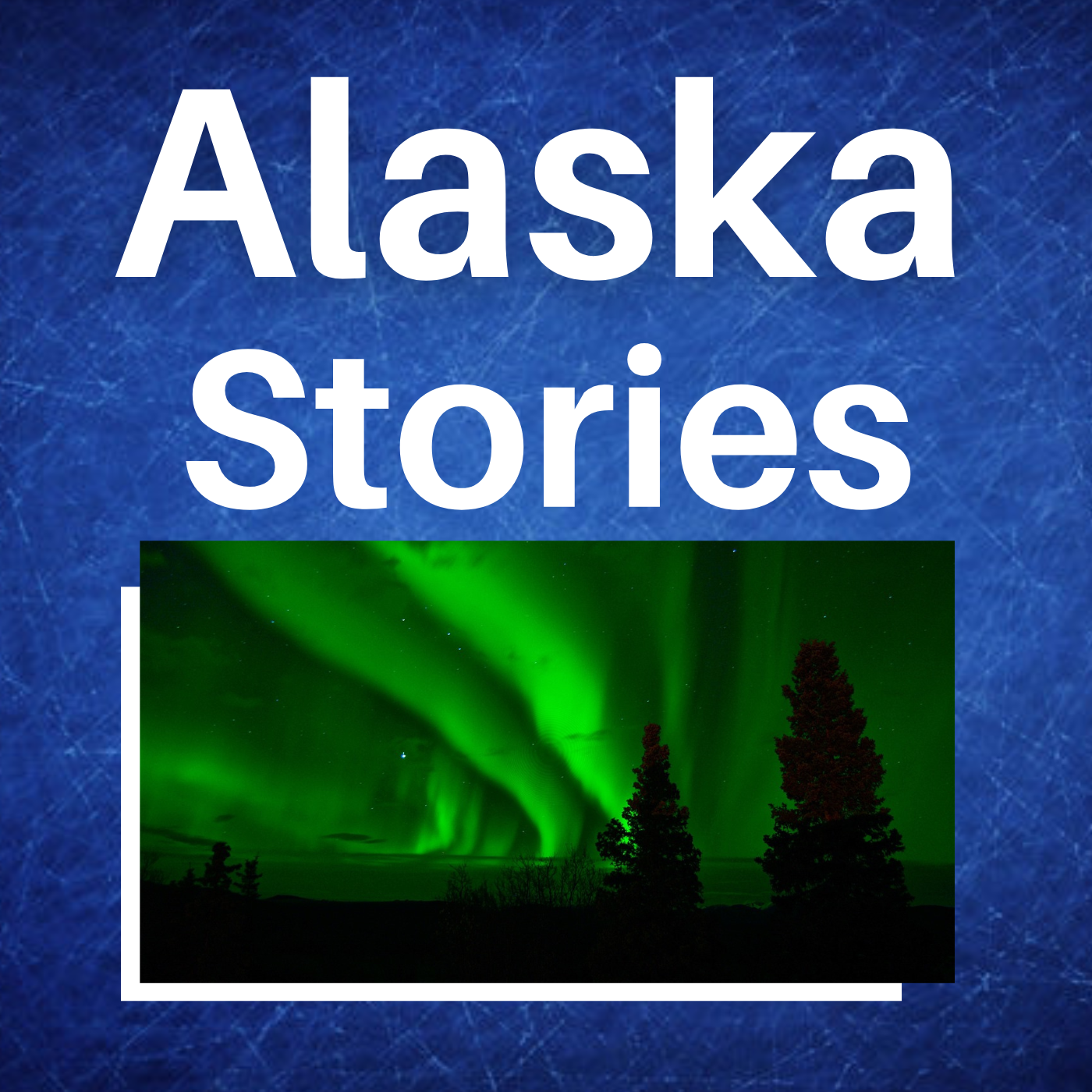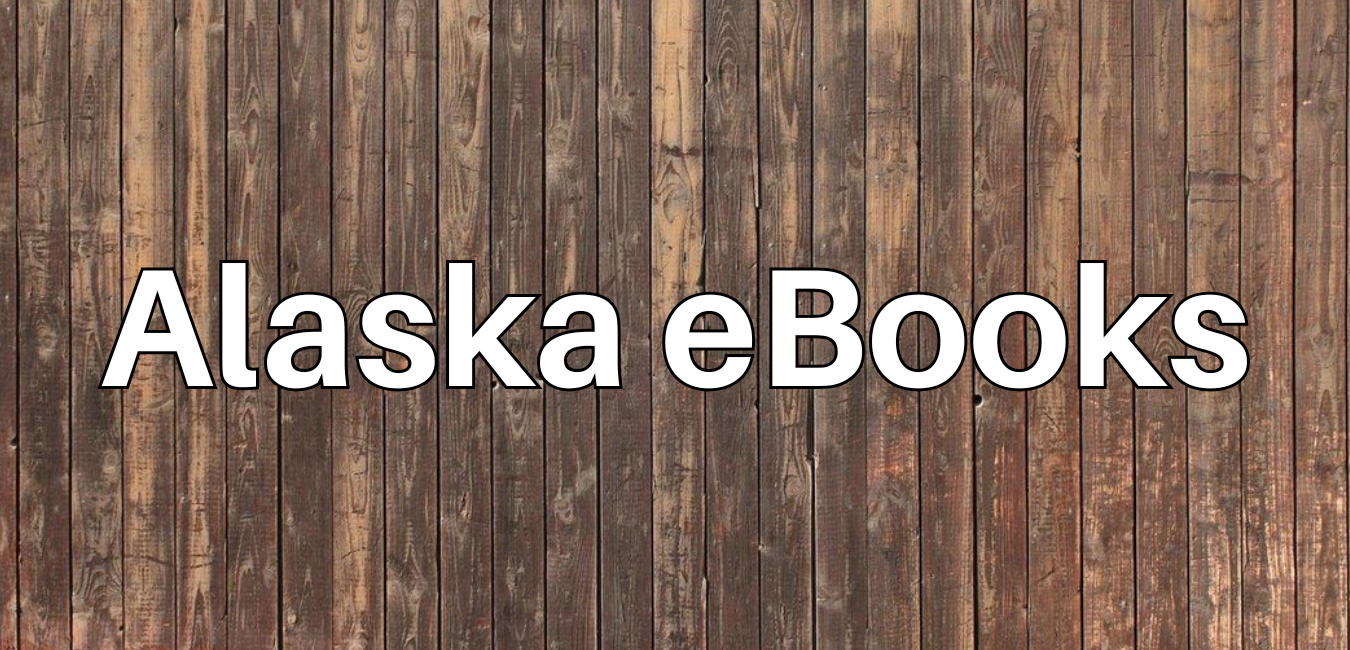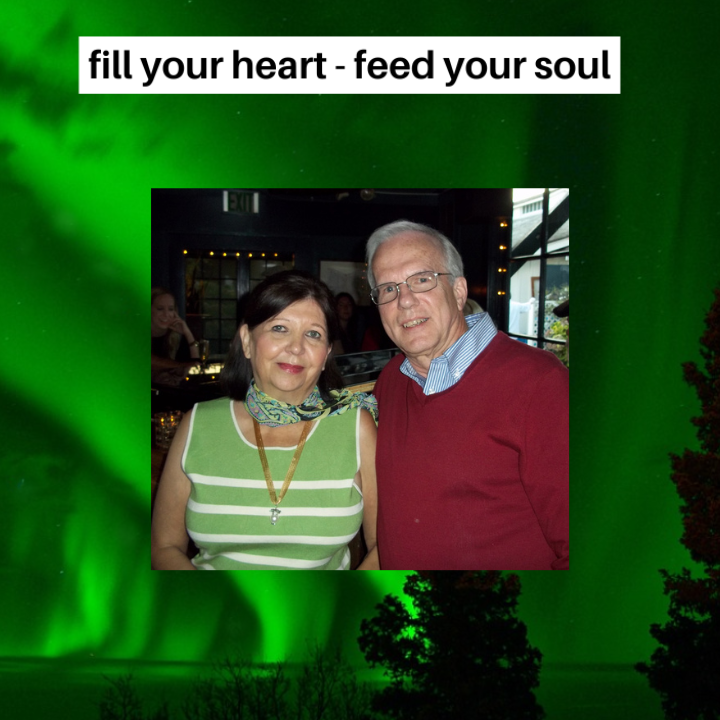Old Alaska Highway Memories
Old Alaska Highway stories from travelers who made their way over this incredible road.
Click on the following
to hear the introduction
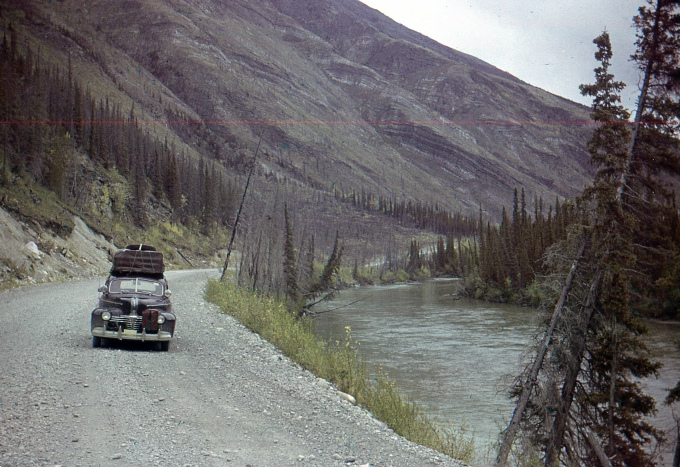 A long, lonely stretch of gravel-covered road.
A long, lonely stretch of gravel-covered road.The road is also known as the ALCAN, or Alaska Canadian Highway.
Those
Old Alaska Highway
Curves
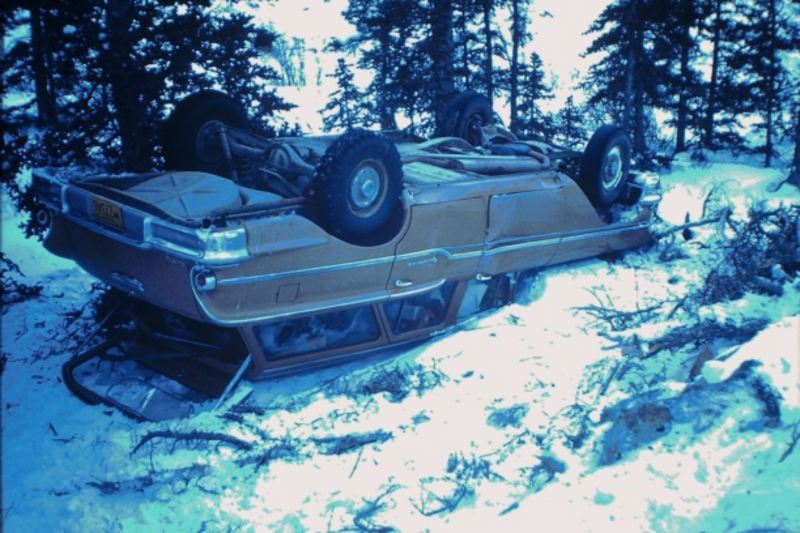 photo courtesy Joe Fournelle
photo courtesy Joe FournelleJoe Fournelle takes you on a 1959 trip on the old Alaska Highway.
From Joe's story:
"Our family left Tok on the morning of January second, not sure of our destination.
We never reached it.
About 4:30 in the afternoon at the sharp 90-degree bend to the right at mile 1061, my dad overcorrected going around the bend, and the luggage rack on the roof of the car caused the car to overturn off the road."
Breakdown on
the Old Alaska Highway
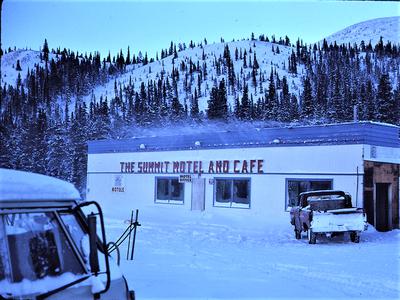
Ron Proctor tells the story of taking his VW Bus on an adventure he will never forget.
From Ron's story:
“On
Friday morning, without any road services in the area, I cautiously
began to drive the bus from the Hot Springs and got as far as milepost
462 at the town of Toad River along the highway.
At the
gas station there, a mechanic gave me the grim news: the generator had
blown and the fan belt which cooled the engine burned off. He knew a
mechanic at Summit Lake, 35 miles south of Toad River, who had a
Volkswagen generator and arranged to deliver it the following
day.”
Our 1968
ALCAN Adventure
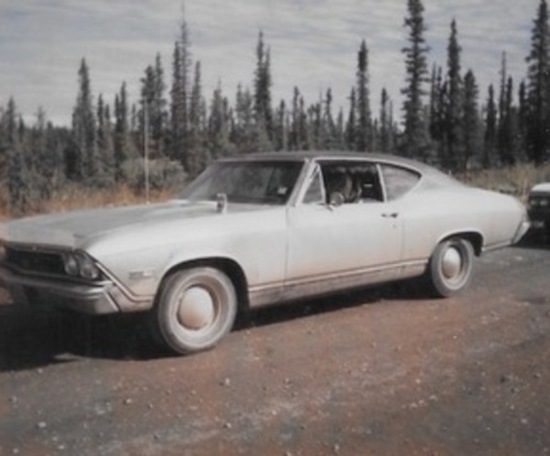
"In some places I swore we were driving on an old creek bed. The road was really bad."
from Jack and Donna Wernet's story:
"My wife was outside the car when she suddenly took in a sharp breath and hollered, "Jack, there's a bear coming out of the woods!"
I told her to keep an eye on it while I finished up (repairing the trailer)."
March 1966
on the Alaska Highway
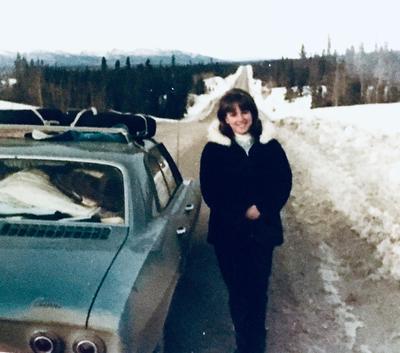
“It was March 1966, when my husband and I left the big city to go somewhere that scared me to death.”
Destination: Anchorage, Alaska
From Marci's story:
“Watch out for the semi's”, one of them said.
“They drive fast and will kick up gravel. If a rock hits your windshield, get the truck's license plate number. They'll pay for the repair.” “And stop for moose. If you hit one, it will total your car,” said another. “And don't forget,” he continued, “if you see a car on the side of the road, you have to get out and see if the driver needs help.”
Traveling with
a White Cat Pink Tail
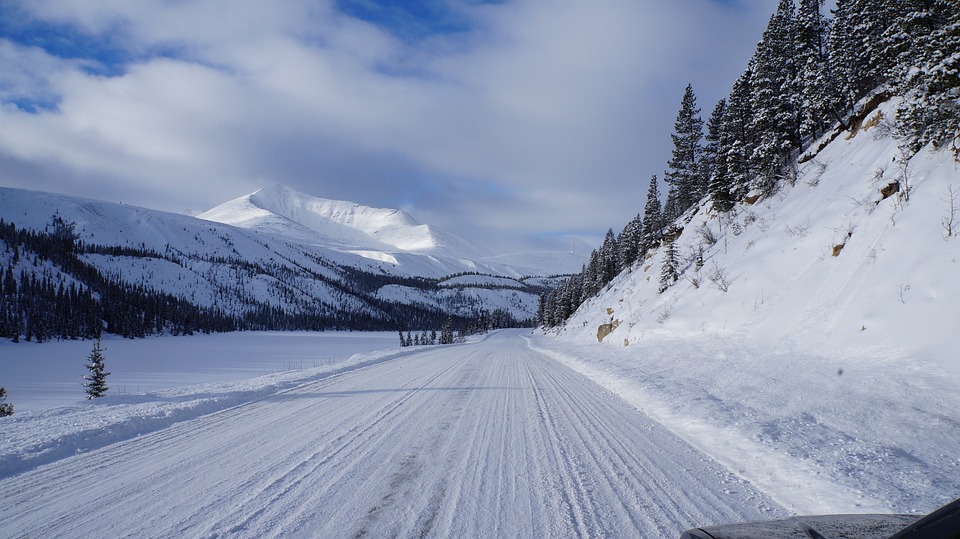
How do you find a white cat in the snow along the old Alaska Highway?
Author Rick Hood tells this story about a trick that worked on a family pet.
From Rick's story:
“Both cats were great rabbit hunters accustomed to North Carolina woods but not so much to snow.
We
didn't worry particularly about the Seal Point Siamese, but we feared
the long-hair white Persian might be difficult to spot in the snow if
she ever did escape the car.”
Drove
the ALCAN
So Many Times
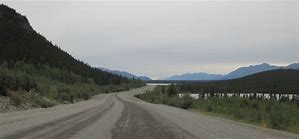
"On one trip, we ended up with a hole punctured in our gas take.
We stuck some gum in the hole until we could get it fixed."
From this story by Becky-Cowen-Cornelius:
“One year we got 3 flat tires at the same time. My dad had to walk a ways to the nearest gas station and thank
God there was one reasonably close by, I haven't a clue what we would
have done if there wasn't one.”
No Ordinary Canary
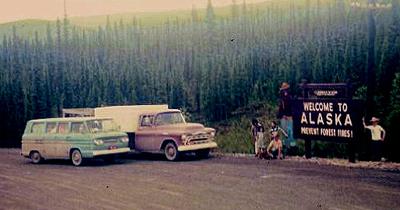
This family traveled the old Alaska highway with a dog and a bird.
Follow their adventures on the road, back when it was a tough drive.
From the story by Mark Ransom:
“At age 11, I traveled the ALCAN Highway from Wyoming to Anchorage with
my father, my mother, my sister and two brothers — not to mention a dog,
a captured ground squirrel, and a canary — to start a new life in
Anchorage.”
What I Learned
Driving the Highway
Seven Times
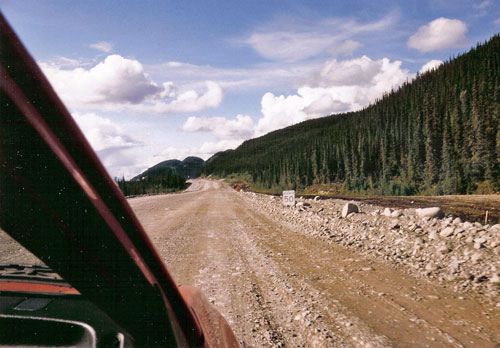
Ric drove the highway during the 1960s, when it was mostly a gravel road.
He used different vehicles and remembers his time on the ALCAN.
From the story by Ric Swenson:
“More gravel road and just one flat tire. Using a jack on the side of a gravel road proved to be a challenge, but I got it done at last. Several kind folks stopped and asked if I needed help, but I thanked them and fixed it myself.”
Her Family has
a History
on the Highway
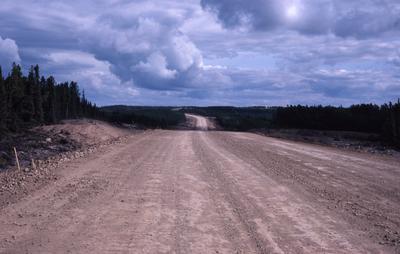
From 1957, when the Old Alaska Highway was a narrow two lane dirt road, to 1972 when portions had been paved, her family experienced the road many times. Enjoy her story.
From the story by Jaqueline Biggs:
“The road was gravel, and quite a few of the rivers had no bridges yet – just wood planks.”
BONUS
Old Alaska Highway
Diary
1947
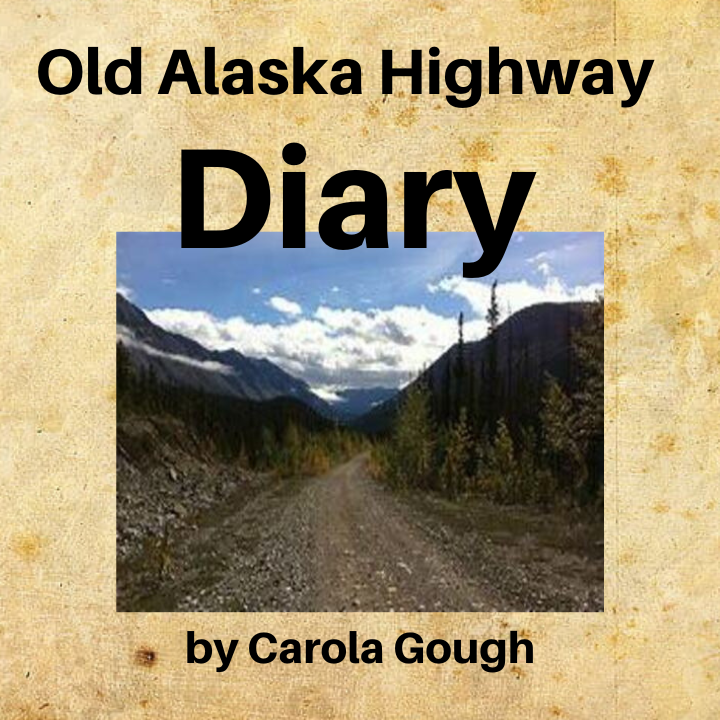
Carola Gough kept a diary of the families 1947 Alaska Highway adventure.
From her Diary:
“The road is terrible, wet, and slippery. Up and down we go. Just passed cliffs where we could see coal. Looks like sunshine ahead. There's a rainbow against the mountains. Bought gas at Summit Lake. We had planned to fish here, but they say there are no fish in the lake. Clemma must have meant Summit Lake, Alaska. So we'll go on and do our 200-mile stint – 20 miles to go.
Across the mountains we can see for miles,
trees, mountains, clouds, nothing but wasteland. Surely is lonesome.
Stayed at an old road on top of the mountains, cooked dinner and stayed
overnight. Wieners and macaroni sure made a hit with everyone.”
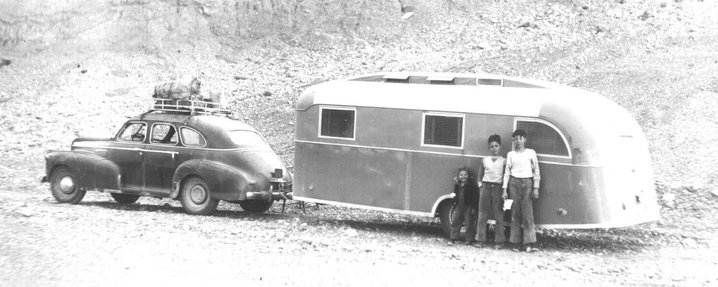 The Gough family on the Highway
The Gough family on the Highwayphoto courtesy of Gene Gough
You can read about
the Gough family's 1947 trip
in this diary kept by Carola Gough.
Take a look at this
and enjoy
The Flat Tire Problem
Circa 1954
Photo below courtesy of Dorothy Fry
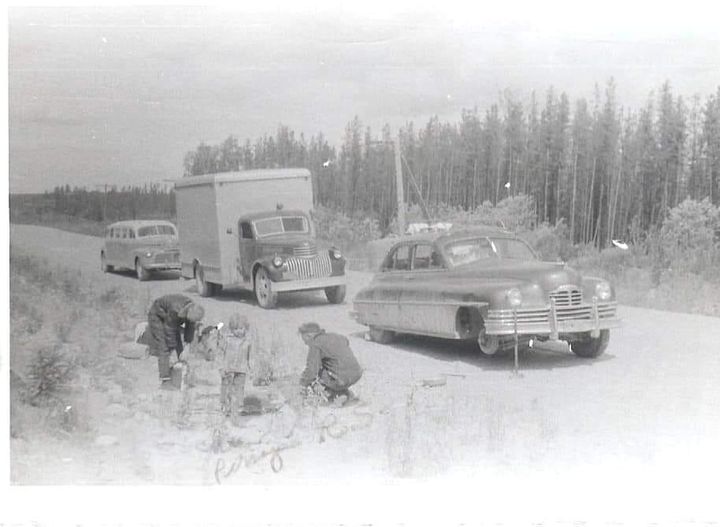 Flat tires were common in the early days
Flat tires were common in the early daysIn the Picture:
Dorothy Fry (little girl), David (brother) and Roy (dad)
If you traveled the Old Alaska Highway in those days when most of it was gravel, you know first hand that flat tires were a real problem for travelers.
In some stories on this page, you'll read accounts where it wasn't just one flat tire, but multiple flats at the same time. And when that happened, travelers relied on the kindness of other travelers to help them out.
But a flat tire on the highway could also be a blessing in disguise.
It gave everyone in the car a much-needed break. If you were traveling with children or teenagers, they enjoyed getting out of the car while someone changed the tire. And if you were the driver, it was nice to let go of the steering wheel and have a different view that didn't include the road ahead. If only for 10 to 15 minutes.
Old Alaska Highway
Memories
Photos below
courtesy of Erik Park
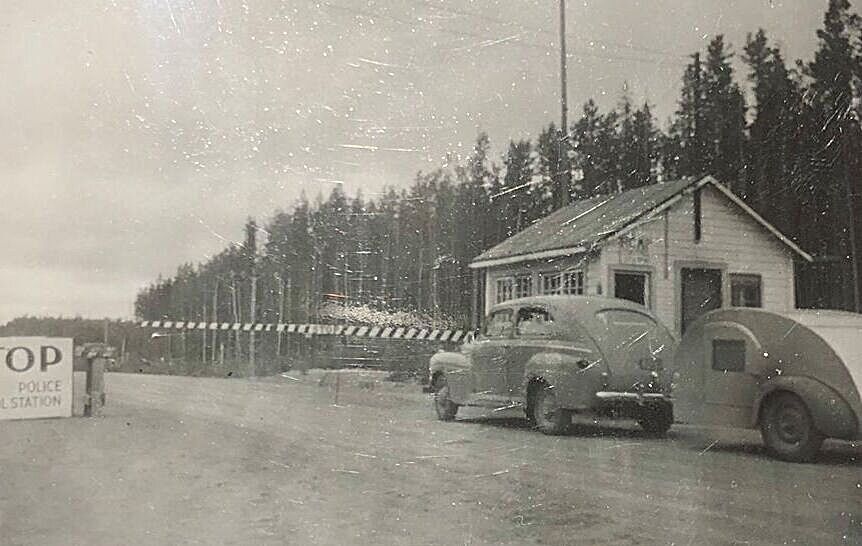 A checkpoint along the highway
A checkpoint along the highwayErik's mom traveled the highway with her family in 1947 from Boulder, Colorado to Alaska, and the following year she graduated from Anchorage High School.
The adventure of driving over the old Alaska highway to a new and distant place was a challenge. At the end of their journey, what would they see, what would they experience? One thing was sure. They would never forget the highway. And they had stories to tell.
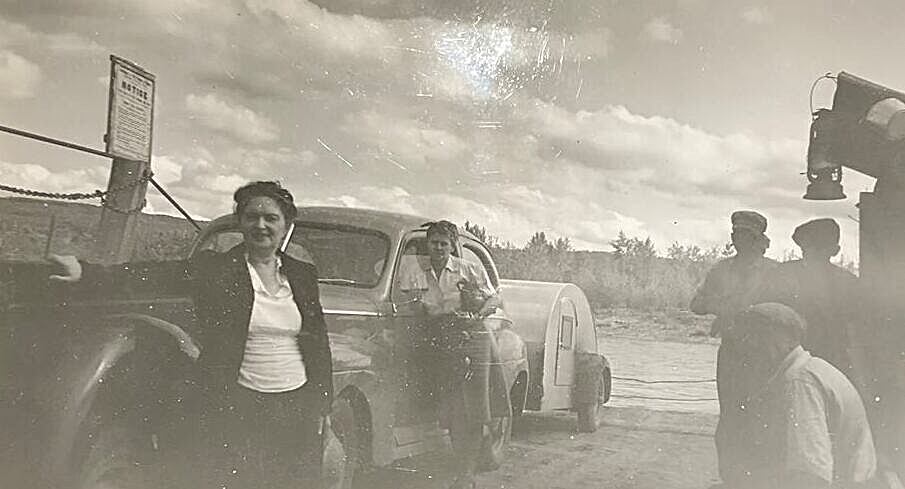 A welcome break along the road
A welcome break along the roadFor travelers on the highway, taking a break from being in a moving vehicle driving along the twists and turns of the narrow road was more than welcome.
Just to stand up for a while and stretch their legs. To take a short walk, or even enjoy the beauty that surrounded them on this famed road. Yes, taking a break was a welcome part of the journey.
1950s
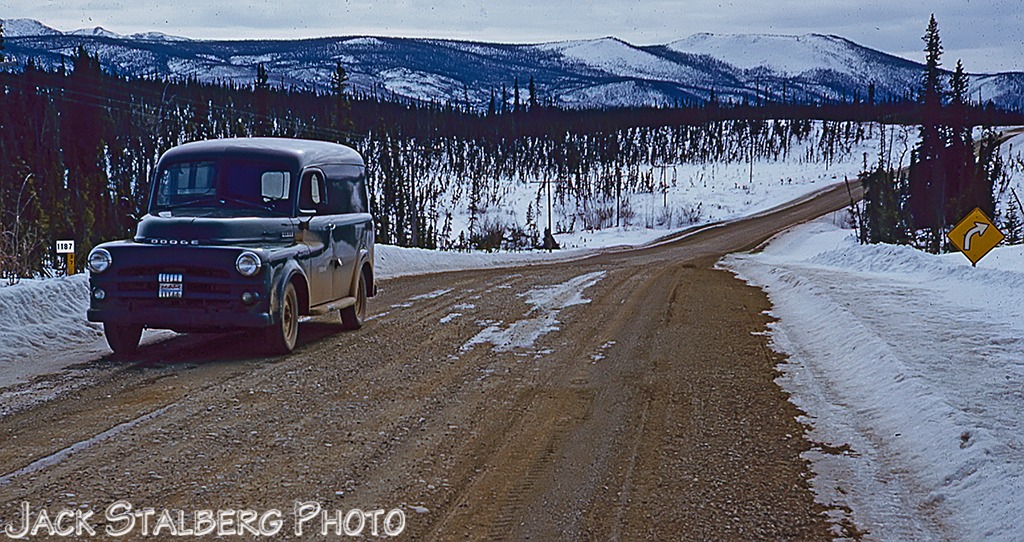
The photo above by Jack Stalberg shows the barely two-lane road on a cold day. This picture tells an old Alaska Highway story.
Notice how beautiful but stark it is in the picture above.
And the contrast of the brown road against the snow-covered landscape is at once beautiful and striking. You can almost feel the cold.
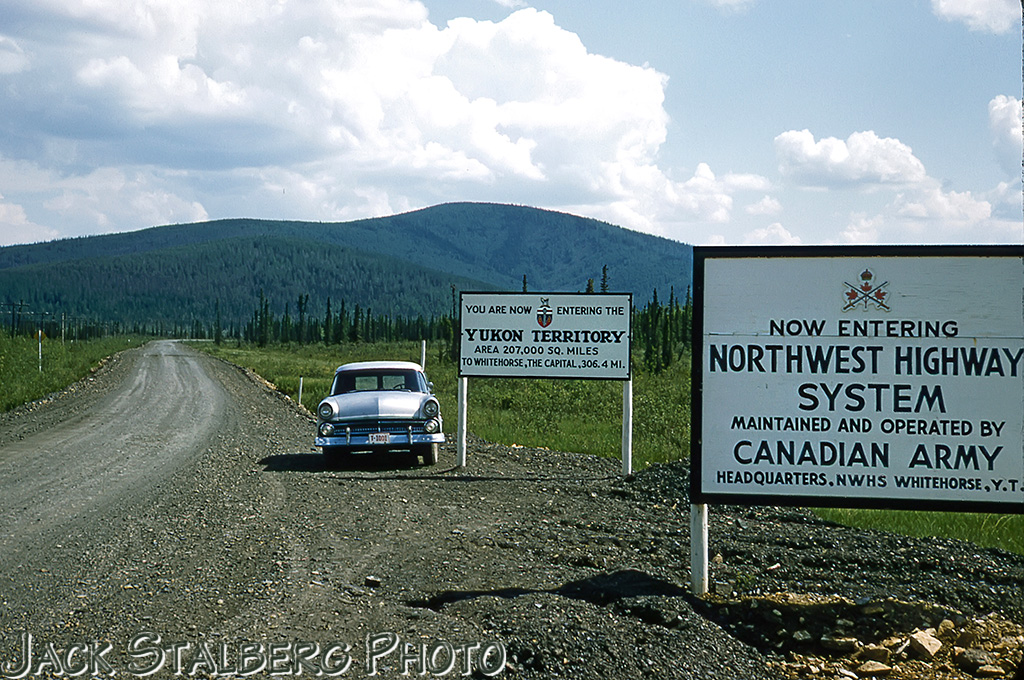
In this Jack Stalberg photo, the signs read that you are entering the Yukon Territory and that it's over 300 miles to Whitehorse.
Just imagine how many vehicles have stopped at these signs for a few minutes. Maybe they got out and took pictures, or perhaps they gave themselves some time to simply look around and enjoy where they were.
1951 on the Highway
Photo below
courtesy of Nick Daggart
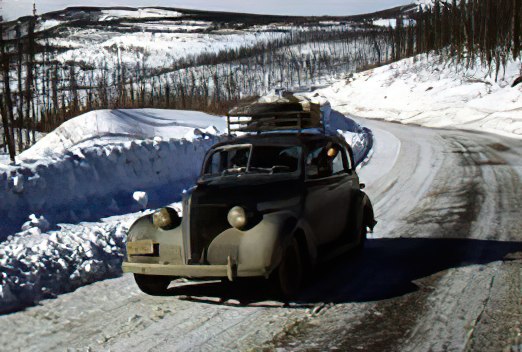 Winter time on the old Alaska highway
Winter time on the old Alaska highwayJust look at the early day travelers in the photo above.
Can you imagine?
But the difficulties and trials, encountered during the early days of the Alaska Highway, did not keep those pilgrims from their goal of reaching Alaska.
Watson Lake Sign Post Forest
in the Yukon Territory
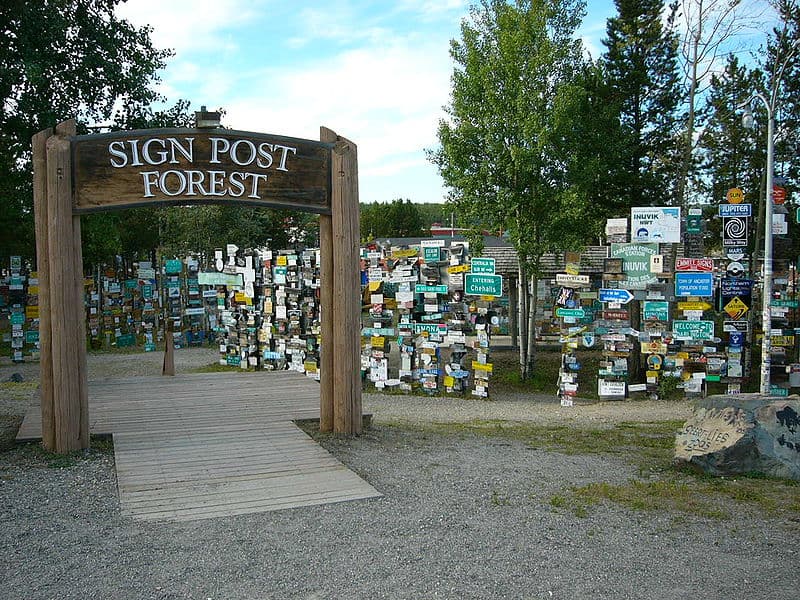 A fun stop along the way
A fun stop along the wayDid you know about this unique stop along the highway?
Thousands and thousands of travelers stop to rest at the Watson Lake “Sign Post Forest” and many have contributed to this very different place by telling their ALCAN Highway stories with the signs they leave behind.
When you visit, and you really take the time to look, you'll spot signs and license plates from all over the world. Motorists brought many signs from their original location somewhere else on earth and gave them a new home in the Sign Post Forest.
Old Alaska Highway
Memories
The road first opened around 1947.
For the many years that followed, it was nothing more than a barely two-lane gravel-covered dirt road that curved around all over the place.
In
the summer it was dusty, and when it rained, the fine dust turned into slick, slimy mud. It was a very hard drive.
Back then, gravel constantly pelted the underside of your car. And the rocks on the road caused many flat tires.
As cars and trucks passed you on the other side, gravel flying through the air routinely broke headlights and cracked thousands of windshields.
In fact, replacing headlights, windshields and repairing flat tires became a reliable source of income for the few service stations along the way.
But gas stations weren't the only things that were scarce along the Old Alaska Highway back then.
Grocery
stores and places to eat and stop
for the night were few and far between. If you were driving at night,
stopped your car, and turned off the motor, what you heard was total
silence. Especially in the Yukon Territory, where there are miles and
miles of nothing but wilderness.
When you had a breakdown out in the middle of who knows where, you were totally at the mercy of others who were driving on the road. Fortunately, drivers would always stop to offer assistance.
In the winter, the highway presented different problems. Ice and snow covered the road, and driving conditions and cold temperatures were dangerous.
A story about the early days:
by GJ Wilson
“My husband's first trip over the newly opened ALCAN was just a couple of weeks after it opened up to civilians.
He went out with Wasilla Betts Brothers Trucking to pick up new trucks in Seattle to bring back to Alaska. Two men each in three trucks. Coming back, it was (minus!) -70 degrees at Rancheria. To get the trucks started in the morning, they had to scrape a can of oil with a putty knife and heat it up to put it in the truck. When they got the trucks started, some Army vehicles required a pull. They crawled under the trucks to heat the engines with a blow torch.
For me, the first of many was driving out on the old Alaska Highway in October 1946. We had 15 flat tires on the way. Inner tubes were difficult to find because of the shortage of rubber for WWII use. Many hot-patches fixed old inner tubes that had burst, and my parents took turns hand pumping the tires with a bicycle pump.
We, and other travelers, carried gasoline and food with us as businesses were extremely sparse at the time. We were really sick of fried chicken and wieners by the time we reached our destination.
It took us 15 days and 15 flats!”
Old Alaska Highway
Memories
Back in the day,
the highway was
one heck of a journey.
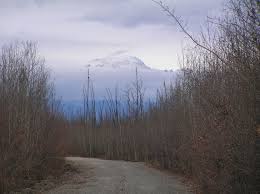 Can you imagine traveling this road?
Can you imagine traveling this road?As you read this story, you'll find yourself riding along for an adventure on this historic road.
The military put together the Alaska Canadian Highway, or “ALCAN” during World War II as a military route. They had to carve it out of the wilderness. The completed road was an unforgiving experience for the hearty souls who braved the challenge.
Years later, while the highway was a bit more tame, it was still not for the faint of heart.
My Families
First Time
on the ALCAN
By Mike of Anchorage Memories.com
The Old Alaska Highway was a narrow, gravel-covered dirt road that wound its way through the Canadian wilderness like a drunken snake had charted its course.
In the summer, the constant sound of gravel flying off your tires and pelting the undercarriage of your car, truck, or camper could be maddening.
Flat tires were common, as were broken headlights and windshields from gravel tossed up off the road by passing cars and trucks.
Driving the road and surviving was a badge of honor.
While it was only a barely two-lane dirt path, it was always a highway.
The highway begins in Canada at Dawson Creek and ends some 2012 miles later at Delta Junction, Alaska.
The first time our family drove on the road, we went from Anchorage to Montana and then on to Texas.
As we began our adventure, the drive on pavement from Anchorage to Delta Junction was uneventful. But back then, there was no pavement like there is today. And once we entered Canada, we only drove 20 miles or so on the gravel before we had our first flat tire.
That first evening we pulled into Beaver Creek, Canada, and spotted a huge log hotel that also had a restaurant. We happily stopped there for a much-needed dinner and stayed the night.
The next morning we got up early, ate breakfast, and took off on our first full day of driving on the legendary dirt road that cut its way through the beautiful Canadian wilderness.
As we drove along, we saw cars, trucks, and campers that had all kinds of odd-looking contraptions mounted on the front of the vehicles to prevent rocks from breaking their headlights. Most were gizmos made of wire mesh. Back then, the gravel would hit the undercarriage of your vehicle hard enough to puncture your gas tank. As a result, some people even fastened different types of padding under their car, truck, or camper to help absorb the impact of flying rocks.
One
thing I remember about the Old Alaska Highway was road
courtesy. If you came upon a vehicle stopped along the
road, instead of just driving by, you would stop and ask if they needed
help.
We experienced trouble with our car just as we were coming into Fort Nelson. Our engine started
sputtering, and we barely made it to a service station. Once there, the
mechanic informed us that we required a part, but they
would have to order it.
We ended up staying at a local hotel for several days waiting for the part to arrive.
Later,
when we were back on the road and in the middle of nowhere, a large
truck came around a curve. The truck was going pretty fast, and it threw
gravel up into our headlights, breaking one of them.
As it got darker and darker, we
continued to drive until we came to a small
settlement where we pulled into a service station, hoping they could fix
our broken headlight. Fortunately, after some digging around, they found
the one bulb they had that would fit our car.
Back on the highway later that night, we pulled into a town and found a small hotel. We checked
in, and the desk clerk gave my mom the room key. When we got to the
room, Mom handed me the key and said, “Mike, my hands are full; you open
the door.”
I put the key in the lock, turned it, and opened the
door. As I did, a lady in the room sat up in bed, looked at me, and
screamed.
I said, “Sorry,” and quickly shut the door. Shocked and embarrassed, we wasted no time going back downstairs to see the desk clerk. When we told him what had
happened, he said, “Sorry, I'm new; I gave you the wrong room key.”
Moments later, with
a new room number and key in hand, we went back upstairs. This time, I
made sure I wasn't the one who opened the door to our room.
The
rest of our drive was uneventful, and when we finally ended up back
on pavement, it felt like we were floating on a cloud.
On our return trip, heading back to Anchorage, we were in the Yukon as we pulled into a café and hotel in Destruction Bay.
While
eating our lunch, some Canadian Mounties came in and told everyone that
the road ahead was closed because of a washed-out bridge.
We ended up having to spend nearly a week in the hotel while the bridge was being repaired.
I
remember the day the Canadian Mounties came back to the hotel and
informed us that they had reopened the bridge, and we could head on up
the highway anytime we wanted.
Finally, back on the road and headed
for Alaska, we were curious to see the bridge that had been washed out.
Much to our surprise, the bridge ended up being nothing but a tiny
structure over a small creek.
At the end of our journey, when we were back in Anchorage and our adventure had ended, we were all happy to be off the road.
Pavement has made it a smooth ride now. And there are a lot more services available along the way. But I remember when driving that narrow, gravel-covered old Alaska highway required a lot of courage.
Since that first trip as a young boy, I've driven the road in all seasons: winter, spring, summer, and fall. It's beautiful, but it can still be an exhausting drive.
Yes, I'm an Alaskan, and I earned my ALCAN Highway badge of honor.
“I totally loved your description of the highway. It matches my memories exactly.” Linda
It was an all Dirt Road
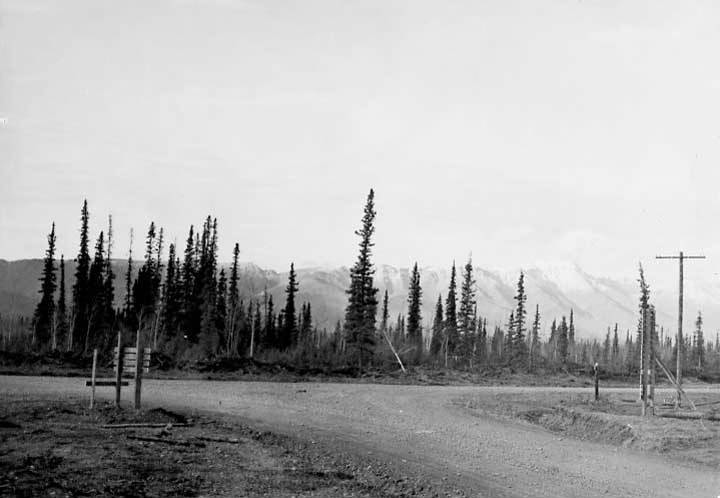 Near Tok, Alaska 1943
Near Tok, Alaska 1943The Old Alaska Highway
These days, the road is more like a very long Sunday drive.
It's paved, and there are many places where you can pull over, get gas for your car, have breakfast, lunch, or dinner, and stay for the night.
Depending on the time of year, you can even go fishing hiking or take pictures to share with friends and family.
When you drive the highway today, try to imagine what it was like when it was just a narrow, barely two-lane, gravel-covered dirt road. Then try to imagine how difficult it was for the many thousands who drove the old Alaska highway.
Adults, who as children took the journey with their parents, still recall the remarkable road. And they have plenty of interesting stories to tell about how their family made the trip.
Everyone who traveled the Old Alaska Highway has memories for a lifetime.
BONUS
BONUS
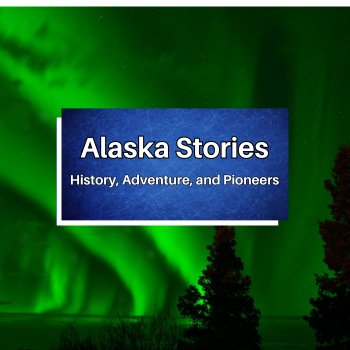
Join for FREE and get Alaska Stories
from two Alaskans

